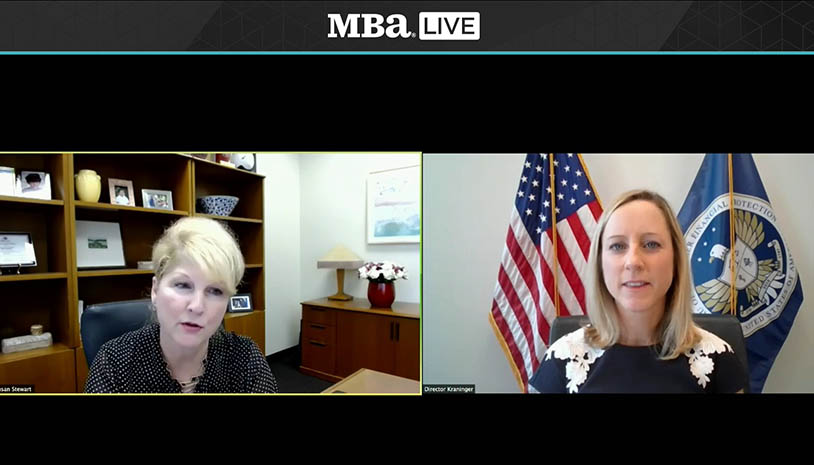
CFPB Extends GSE Patch ‘Indefinitely;’ Kraninger Stresses Flexibility

With less than two weeks before the 2020 elections, Washington is doing what it does best—speculating. Kathy Kraninger, Director of the Consumer Financial Protection Bureau—a federal agency at the heart of much of that speculation—is paying it little attention.
In a wide-ranging discussion during the Mortgage Bankers Association’s virtual Annual Convention & Expo, Kraninger told MBA Chair Susan Stewart that the Bureau would continue to move forward with its agenda of easing regulatory burdens and providing mortgage lenders and servicers with greater flexibilities in working with customers.
“We want to have clear rules,” Kraninger said. “And we want everyone to follow the same rules.”
As if on cue, the CFPB this afternoon issued a final rule (https://files.consumerfinance.gov/f/documents/cfpb_atr-qm-patch-extension-final-rule_2020-10.pdf) to extend the Government-Sponsored Enterprise Patch until the mandatory compliance date of a final rule amending the General Qualified Mortgage loan definition in Regulation Z. The GSE Patch was scheduled to expire on January 10.
“We knew the patch was scheduled to expire in 2021 and we knew we would have to take on this rulemaking,” Kraninger said. “We issued the proposal and are currently taking a look of the comments. We believe that a pricing threshold is a more realistic assessment of an individual’s ability to repay. Looking again at that stakeholder feedback, we are moving forward with what we think a new QM threshold should be.”
Kraninger said the Bureau is taking extending the patch “to ensure that responsible, affordable credit remains available to consumers who may be affected if the GSE Patch expires before the mandatory compliance date of a final rule amending the General QM loan definition.”
The Bureau issued a proposal to amend the General QM loan definition on June 22, the same day it issued a proposal to extend the GSE Patch. The Bureau is currently developing a final rule amending the General QM loan definition and is planning to issue it at a later date.
Kraninger emphasized that the Patch will remain in place until a new standard is implemented. “We are operating under the rubric of the law; the congressionally mandated standards remain in place and we want individual lenders to have the flexibility to calculate the standards that best suit their models,” she said.
The coronavirus pandemic, Kraninger said, has spurred the Bureau to develop more agile approaches to assisting homeowners and guiding lenders and servicers.
“The CARES Act gives us a lot of flexibilities in helping homeowners,” Kraninger said. “We’ve reached more than four million borrowers so far, but there are so many other people who need this information. I want to thank all the lenders and servicers who also got all that information to our stakeholders.”
Kraninger said the Bureau is also looking at an issue that is high on MBA’s priority list: mortgage loan originator compensation. MBA has called for flexibility for lenders in how they compensate MLOs, and Kraninger indicated that the Bureau is open to such flexibility. “We are looking to permit lower LO compensation on loans, as well as providing more flexibility for lenders to lower LO compensation in case of LO errors,” she said.
Kraninger also said the Bureau will continue to issue “no-action” letters—a reversal from previous policy in which Bureau letters appeared to carry weight of rule or law.
“We’ve worked to put innovation policies in place and to create clarity in areas of uncertainty,” Kraninger said. “Our first no-action letter was on housing counseling, enabling lenders to partner with housing counseling agencies that are providing consumers with assistance. We will continue to create such clarity.”
